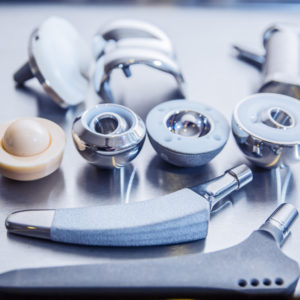Zimmer Hip Implant Lawsuit Filed Over Corrosion, Blood Poisoning and Failure

Problems with the design of a popular Zimmer hip implant system, which consists of the M/L Taper Hip and Versys femoral head, allegedly resulted in corrosion, metal blood poisoning, premature failure and the need for revision surgery, according to a recently filed product liability lawsuit.
The complaint (PDF) was brought by Richard P. Torres and his wife, Pollyanna, in the U.S. District Court in the Western District of Michigan on July 24, naming Zimmer Biomet Holdings, Inc. as a defendant.
Richard Torres indicates that he underwent total right hip replacement surgery in February 2014, at which time a Zimmer VerSys Hip Stem Femoral Head was implanted with an M/L Taper femoral stem and a Trilogy Acetabular Shell and Liner.

Learn More About
Lawsuits are being reviewed for several different dangerous and defective hip replacement systems.
Learn More See If You Qualify For CompensationBy late 2017, Torres began to suffer increasing pain and instability in his right hip, and his surgeon tested his blood for ion levels. High ion levels are a sign of metallosis; a form of blood poisoning often linked to fretting, corrosion and debris shed from cobalt and chromium hip implant components.
The Zimmer VerSys femoral head is made of cobalt and chromium, and it has been linked to problems with corrosion and blood poisoning when used with the M/L Taper femoral stem, resulting in premature failure in many recently reported cases.
Torres’ blood tests confirmed the presence of elevated levels of cobalt and chromium, and he was prescribed to use crutches or a walker.
In March 2018, Torres was diagnosed with mechanically-assisted crevice corrosion and underwent revision surgery in May 2018. His surgeon noted that there was significant corrosion around the femoral head-neck junction of the Zimmer hip system. During the revision surgery, Torres also developed a left side inguinal hernia, which required additional surgery in June 2018.
“In designing the Zimmer Hip System, Zimmer knew that the use of dissimilar metal alloys as well as taper size and geometry, trunnion surface finish, and flexural rigidity contribute to causing fretting and corrosion at the femoral head-femoral stem taper interface,” the lawsuit states. “Mechanically assisted crevice corrosion (‘MACC’) has been identified as a cause for symptomatic implant failure in metal-on-polyethylene hip devices. MACC produces cobalt and chromium ions, fretting byproducts and corrosive debris that can lead to adverse local tissue reaction.”
Zimmer Hip Lawsuits
Torres’ complaint is one of a growing number of similar hip implant lawsuits filed in recent months over complications involving the Zimmer M/L Taper and VerSys components, which are considered a metal-on-metal design when used together.
Each of the complaints raise similar allegations that the Zimmer M/L Taper Hip Prosthesis and Zimmer VerSys Hip femoral head are defectively designed, and unreasonably dangerous when paired together, with a tendency to fret and corrode, creating metal debris that gets into the patients tissue and blood, resulting in the implants failing and needing to be removed.
More than 100,000 of these Zimmer hip implant systems have been used throughout the United States, according to recently filed court documents. As lawyers continue to investigate and review potential cases in the coming months and years, it is expected that the size of the litigation may increase rapidly.
Last month, a group of plaintiffs filed a motion to centralize all Zimmer hip lawsuits over the VerSys, M/L Taper and M/L Taper with Kinective Technology, asking the U.S. Judicial Panel on Multidistrict Litigation (JPML) to transfer cases filed in various different federal district courts to U.S. District Judge Donovan Frank in Minnesota for coordinated discovery and pretrial proceedings.
The claims are the latest in a number of litigations that have emerged in recent years over recalled and defective metal-on-metal hip replacement systems, which the JPML have previously decided to centralize as part of separate a federal MDLs, including the DePuy ASR, DePuy Pinnacle, Biomet Magnum, Wright Conserve, Stryker LFit v40, Stryker Rejuvenate and other systems.
Metal-on-metal hip designs became increasingly popular in recent years, but components manufactured and sold by various manufacturers have been linked to high rates of failure and problems that often result in the need for revision surgery within a few years.
2 Comments






JeffreyOctober 12, 2020 at 2:31 am
I've had both hips replaced in 2013. The first (the left) went well and to this day I have no complaints. Three months later, I had the right hi p done.same surgeon, same hospital, same t reatment. Only this time, I suffered severe pain and declined rapidly. My leg swelled to twice the size and was very hot to the touch. Blood results indicated high levels of cobalt in my system which were slowly [Show More]I've had both hips replaced in 2013. The first (the left) went well and to this day I have no complaints. Three months later, I had the right hi p done.same surgeon, same hospital, same t reatment. Only this time, I suffered severe pain and declined rapidly. My leg swelled to twice the size and was very hot to the touch. Blood results indicated high levels of cobalt in my system which were slowly killing me. I underwent a 5 hour revision surgery a year later which may have prolonged my life , but not at the quality I had previously enjoyed. I still have to wear a full length stocking because my leg continues to swell, and I have lost feeling in parts of my leg.
CharlesJanuary 28, 2020 at 5:45 pm
I've had both hips replaced. Not at the same time but not far appart. I think the first was in 2005. They hurt me and have never been right and now its metal on metal.